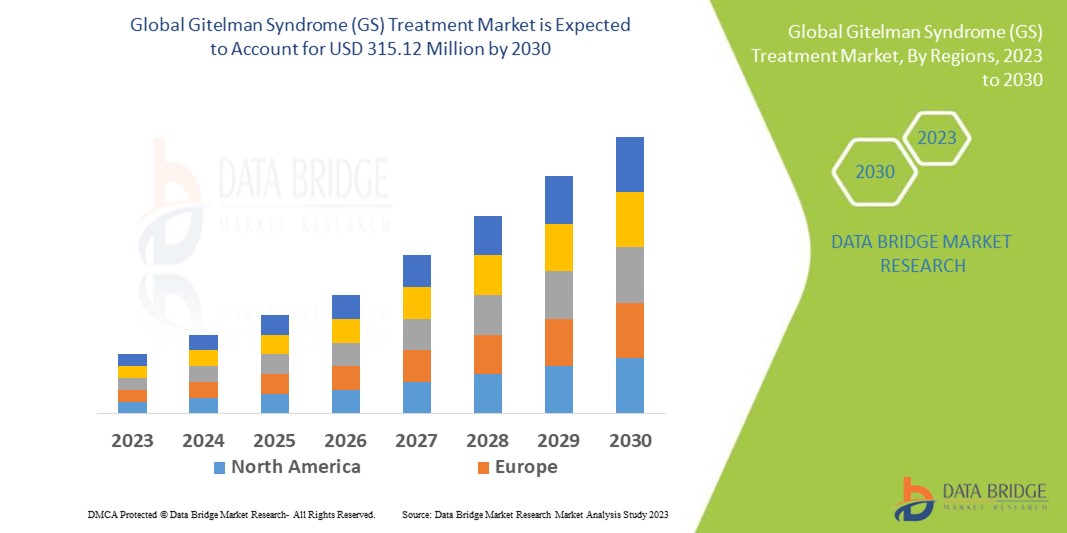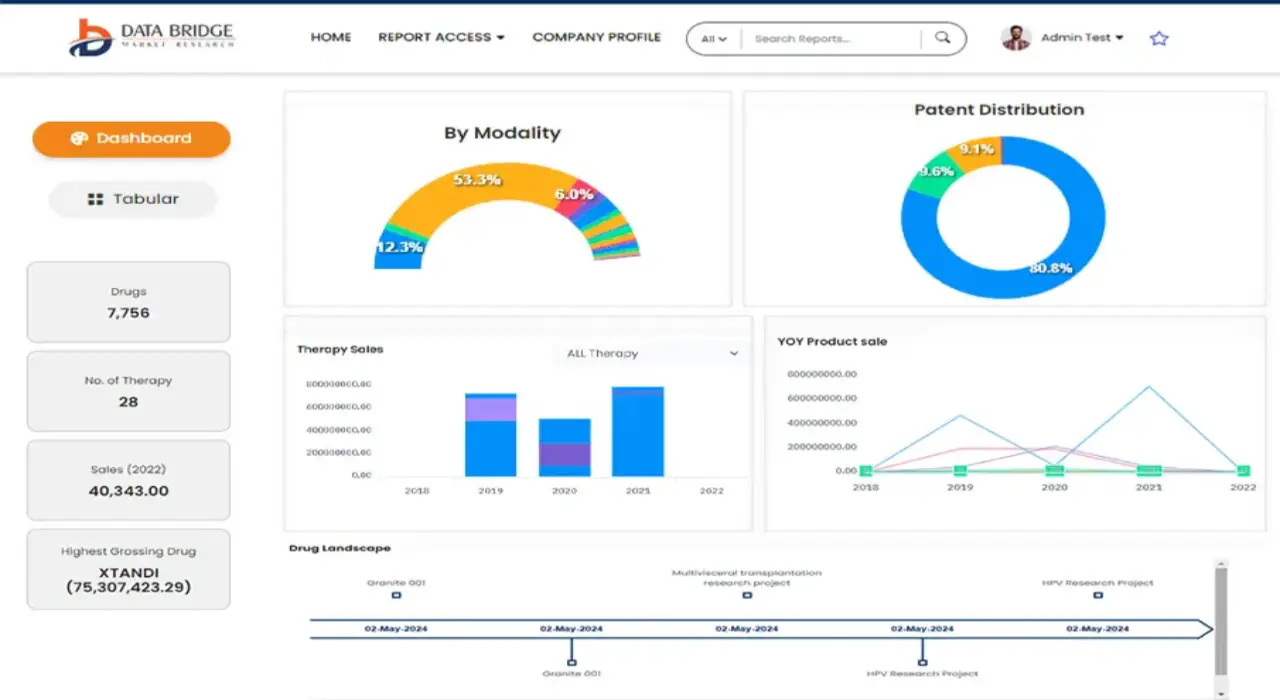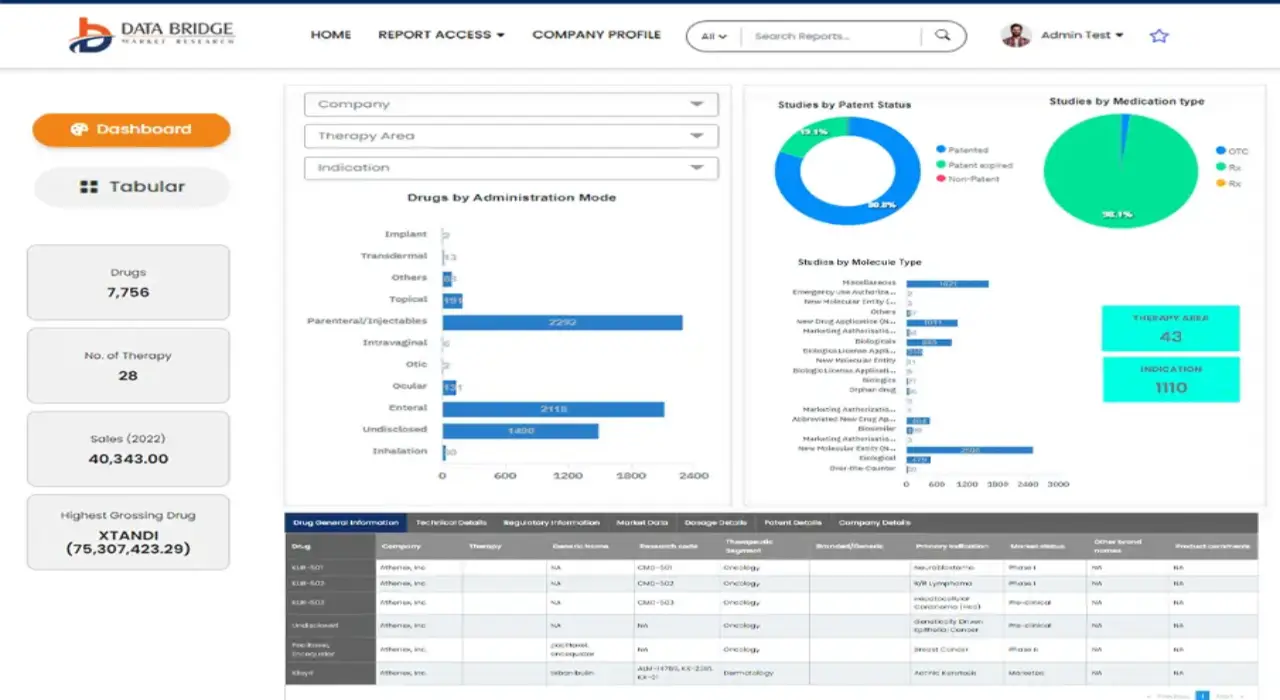Global Gitelman Syndrome Gs Treatment Market
Market Size in USD Million
CAGR :
% 
 USD
184.12 Million
USD
315.12 Million
2022
2030
USD
184.12 Million
USD
315.12 Million
2022
2030
| 2023 –2030 | |
| USD 184.12 Million | |
| USD 315.12 Million | |
|
|
|
|
Global Gitelman Syndrome (GS) Treatment Market, By Diagnosis (Blood Test, Urine Electrolyte Test, Molecular Genetic Test), Treatment (Supplements, Medication), Route of Administration (Oral and Parenteral), End-User (Hospitals, Clinics, Diagnostic Labs, Research Organization), Distribution Channel (Hospital Pharmacy, Retail Pharmacy, Others) – Industry Trends and Forecast to 2030.
Gitelman Syndrome (GS) Treatment Market Analysis and Size
Gitelman Syndrome (GS) Treatment is a chronic inflammatory disorder of follicular and perifollicular skin characterized by papules, pustules, and post-inflammatory hyperpigmentation. It occurs more frequently in men of African and Asian descent. The etiology of PFB is multifactorial. Shaving or plucking the hair precipitates the onset of an inflammatory reaction that results from the penetration of the adjacent skin by the growing sharp tips. The curved shape of the hair follicle allows for the downward curvature and penetration of the growing hair tips into the skin.
Data Bridge Market Research analyses that the global gitelman syndrome (GS) treatment market which was USD 184.12 million in 2022, is expected to reach USD 315.12 million by 2030, and is expected to undergo a CAGR of 5.5% during the forecast period of 2023 to 2030. “Blood Test” dominates the diagnosis segment of the global gitelman syndrome (GS) treatment market due to high prevalence of gitelman syndrome (GS) treatment. In addition to the insights on market scenarios such as market value, growth rate, segmentation, geographical coverage, and major players, the market reports curated by the Data Bridge Market Research also include depth expert analysis, patient epidemiology, pipeline analysis, pricing analysis, and regulatory framework.
Gitelman Syndrome (GS) Treatment Market Scope and Segmentation
|
Report Metric |
Details |
|
Forecast Period |
2023 to 2030 |
|
Base Year |
2022 |
|
Historic Years |
2021 (Customizable to 2015-2020) |
|
Quantitative Units |
Revenue in USD Million, Volumes in Units, Pricing in USD |
|
Segments Covered |
Diagnosis (Blood Test, Urine Electrolyte Test, Molecular Genetic Test), Treatment (Supplements, Medication), Route of Administration (Oral and Parenteral), End-User (Hospitals, Clinics, Diagnostic Labs, Research Organization), Distribution Channel (Hospital Pharmacy, Retail Pharmacy, Others) |
|
Countries Covered |
U.S., Canada and Mexico in North America, Germany, France, U.K., Netherlands, Switzerland, Belgium, Russia, Italy, Spain, Turkey, Rest of Europe in Europe, China, Japan, India, South Korea, Singapore, Malaysia, Australia, Thailand, Indonesia, Philippines, Rest of Asia-Pacific (APAC) in the Asia-Pacific (APAC), Saudi Arabia, U.A.E., South Africa, Egypt, Israel, Rest of Middle East and Africa (MEA) as a part of Middle East and Africa (MEA), Brazil, Argentina and Rest of South America as part of South America |
|
Market Players Covered |
GSK plc. (U.S.), F. Hoffmann-La Roche Ltd (Switzerland), Novartis AG (Switzerland), Astrazeneca (U.S.), Pfizer Inc. (U.S.), Bristol-Myers Squibb Company (U.S.), Sanofi (U.S.), Amgen Inc. (U.S.), Daiichi Sankyo Company Limited (Japan), AB Sciences (France), Eisai Co., Ltd (Japan), Genentech Inc. (U.S), Merck & Co., Inc. (U.S.) |
|
Market Opportunities |
|
Market Definition
Gitelman syndrome (GS) which is also known as familial hypokalemia-hypomagnesemia and hypomagnesemia-hypokalemia with hypocalciuria is kidney disorder which is characterized by the changes in the ions of the body such as potassium, calcium and magnesium. In this condition, the kidney loses the ability to reabsorb the salts which leads to changes in the concentrations of the electrolyte salts and extracellular fluids resulting in dehydration. The symptoms for the disease are muscle weakness, cramps, fatigue, gastrointestinal pain, vomiting, nausea, frequent urination along with polyuria. GS is a genetic disorder which is caused by the mutations in the SLC12A3 gene and is considered as inherited disease. The symptoms are mainly related to the affected people in the family as it is an inherited disease.
Global Gitelman Syndrome (GS) Treatment Market Dynamics
Drivers
- Advancements in Genetic Research
The understanding of gitelman syndrome's genetic basis has deepened with advancements in genetic research. Identification of specific gene mutations responsible for gitelman syndrome has paved the way for potential gene therapies and targeted treatments that address the underlying cause of the disorder.
- Drug Repurposing and Treatment Innovation
Researchers have explored the repurposing of existing drugs, such as potassium-sparing diuretics and magnesium supplements, for gitelman syndrome management. In addition, there has been innovation in the development of novel therapies aimed at correcting electrolyte imbalances in affected individuals.
- Genetic Screening and Diagnosis
Advances in genetic screening techniques have facilitated earlier and more accurate diagnosis of gitelman syndrome. Early diagnosis allows for timely interventions and better management of symptoms and complications.
Opportunities
- Gene Therapy and Genetic Modulation
Gene therapy approaches, such as gene editing and gene replacement, hold promise for gitelman syndrome treatment. Research into genetic modulation techniques to restore normal renal tubule function is ongoing.
- Rare Disease Research Collaborations
Collaborations between pharmaceutical companies, academic institutions, and rare disease research organizations can drive innovation in gitelman syndrome treatment development. These partnerships facilitate the pooling of resources, expertise, and patient data.
Restraints/Challenges
- Lack of Standardized Treatment Protocols
Due to the rarity of gitelman syndrome, there is a lack of standardized treatment protocols. Healthcare providers often tailor treatments to individual patient needs, making it challenging to establish a one-size-fits-all approach.
- Regulatory Compliance and Safety
The development and approval of therapies for rare diseases such as gitelman syndrome involve navigating regulatory hurdles. Obtaining orphan drug designation and meeting regulatory requirements can be time-consuming and costly.
This global gitelman syndrome (GS) treatment market report provides details of new recent developments, trade regulations, import-export analysis, production analysis, value chain optimization, market share, impact of domestic and localized market players, analyses opportunities in terms of emerging revenue pockets, changes in market regulations, strategic market growth analysis, market size, category market growths, application niches and dominance, product approvals, product launches, geographic expansions, technological innovations in the market. To gain more info on the global gitelman syndrome (GS) treatment market Contact Data Bridge Market Research for an Analyst Brief, our team will help you take an informed market decision to achieve market growth.
Recent Development
- In March 2021, “National Rosacea Society”, reported that, 737,960,000 people affected with rosacea while the 420,280,000 people was diagnosed from rosacea. Also it reported that approximately 16 million Americans suffer from rosacea. Such trends are pushing more patients suffering from facial erythema to approach clinics and hospitals
Global Gitelman Syndrome (GS) Treatment Market Scope
The global gitelman syndrome (GS) treatment market is segmented on the basis of diagnosis, treatment, route of administration, end-user and distribution channel. The growth amongst these segments will help you analyse meagre growth segments in the industries and provide the users with a valuable market overview and market insights to help them make strategic decisions for identifying core market applications.
Diagnosis
- Blood Test
- Urine Electrolyte Test
- Molecular Genetic Test
Treatment
- Supplements
- Medication
Route of Administration
- Oral
- Parenteral
End-User
- Hospitals
- Clinics
- Diagnostic Labs
- Research Organization
Distribution Channel
- Hospital Pharmacy
- Retail Pharmacy
- Others
Global Gitelman Syndrome (GS) Treatment Market Regional Analysis/Insights
The global gitelman syndrome (GS) treatment market is analysed and market size insights and trends are provided by diagnosis, treatment, route of administration, end-user and distribution channel as referenced above.
The countries covered in the global gitelman syndrome (GS) treatment market report are U.S., Canada and Mexico, Germany, France, U.K., Netherlands, Switzerland, Belgium, Russia, Italy, Spain, Turkey, Rest of Europe in Europe, China, Japan, India, South Korea, Singapore, Malaysia, Australia, Thailand, Indonesia, Philippines, Rest of Asia-Pacific (APAC) in the Asia-Pacific (APAC), Saudi Arabia, U.A.E., South Africa, Egypt, Israel, Rest of Middle East and Africa (MEA) as a part of Middle East and Africa (MEA), Brazil, Argentina and Rest of South America as part of South America
North America dominates the global gitelman syndrome (GS) treatment market in terms of market share and market revenue and will continue to flourish its dominance during the forecast period of 2023 to 2030, due of the increase in the expenditure for research and development proficiencies, increasing government’s initiatives and improved health care infrastructure in various countries.
Asia-Pacific on the other hand is projected to exhibit the highest growth rate in the global gitelman syndrome (GS) treatment market during the forecast period of 2023 to 2030 owing to the increasing government expenditure on healthcare sector and rising technological advancements and initiatives by the government.
The country section of the report also provides individual market impacting factors and changes in regulation in the market domestically that impacts the current and future trends of the market. Data points such as down-stream and up-stream value chain analysis, technical trends and porter's five forces analysis, case studies are some of the pointers used to forecast the market scenario for individual countries. Also, the presence and availability of global brands and their challenges faced due to large or scarce competition from local and domestic brands, impact of domestic tariffs and trade routes are considered while providing forecast analysis of the country data.
Healthcare Infrastructure Growth Installed Base and New Technology Penetration
The global gitelman syndrome (GS) treatment market also provides you with detailed market analysis for every country growth in healthcare expenditure for capital equipment, installed base of different kind of products for global gitelman syndrome (GS) treatment market, impact of technology using life line curves and changes in healthcare regulatory scenarios and their impact on the global gitelman syndrome (GS) treatment market. The data is available for historic period 2015 to 2020.
Competitive Landscape and Global Gitelman Syndrome (GS) Treatment Market Share Analysis
The global gitelman syndrome (GS) treatment market competitive landscape provides details by competitor. Details included are company overview, company financials, revenue generated, market potential, investment in research and development, new market initiatives, global presence, production sites and facilities, production capacities, company strengths and weaknesses, product launch, product width and breadth, application dominance. The above data points provided are only related to the company’s focus related to global gitelman syndrome (GS) treatment market.
Some of the major players operating in the global gitelman syndrome (GS) treatment market are:
- GSK plc. (U.S.)
- F. Hoffmann-La Roche Ltd (Switzerland)
- Novartis AG (Switzerland)
- Astrazeneca (U.S.)
- Pfizer Inc. (U.S.)
- Bristol-Myers Squibb Company (U.S.)
- Sanofi (U.S.)
- Amgen Inc. (U.S.)
- Daiichi Sankyo Company Limited (Japan)
- AB Sciences (France)
- Eisai Co., Ltd (Japan)
- Genentech Inc. (U.S)
- Merck & Co., Inc. (U.S.)
SKU-
Get online access to the report on the World's First Market Intelligence Cloud
- Interactive Data Analysis Dashboard
- Company Analysis Dashboard for high growth potential opportunities
- Research Analyst Access for customization & queries
- Competitor Analysis with Interactive dashboard
- Latest News, Updates & Trend analysis
- Harness the Power of Benchmark Analysis for Comprehensive Competitor Tracking
Research Methodology
Data collection and base year analysis are done using data collection modules with large sample sizes. The stage includes obtaining market information or related data through various sources and strategies. It includes examining and planning all the data acquired from the past in advance. It likewise envelops the examination of information inconsistencies seen across different information sources. The market data is analysed and estimated using market statistical and coherent models. Also, market share analysis and key trend analysis are the major success factors in the market report. To know more, please request an analyst call or drop down your inquiry.
The key research methodology used by DBMR research team is data triangulation which involves data mining, analysis of the impact of data variables on the market and primary (industry expert) validation. Data models include Vendor Positioning Grid, Market Time Line Analysis, Market Overview and Guide, Company Positioning Grid, Patent Analysis, Pricing Analysis, Company Market Share Analysis, Standards of Measurement, Global versus Regional and Vendor Share Analysis. To know more about the research methodology, drop in an inquiry to speak to our industry experts.
Customization Available
Data Bridge Market Research is a leader in advanced formative research. We take pride in servicing our existing and new customers with data and analysis that match and suits their goal. The report can be customized to include price trend analysis of target brands understanding the market for additional countries (ask for the list of countries), clinical trial results data, literature review, refurbished market and product base analysis. Market analysis of target competitors can be analyzed from technology-based analysis to market portfolio strategies. We can add as many competitors that you require data about in the format and data style you are looking for. Our team of analysts can also provide you data in crude raw excel files pivot tables (Fact book) or can assist you in creating presentations from the data sets available in the report.













